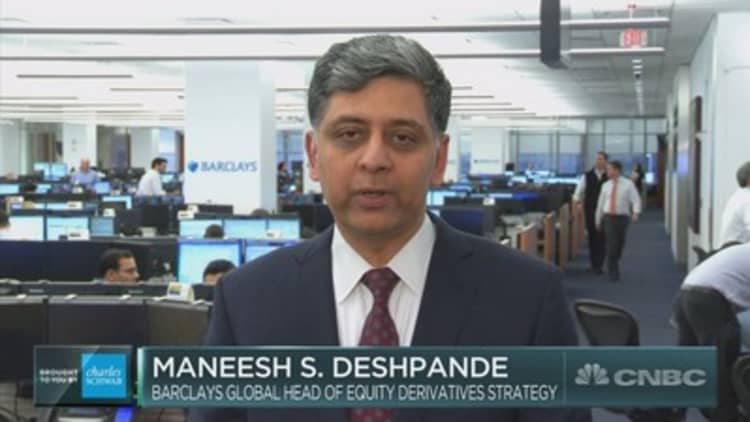
The recent resurgence in market volatility has sent shock waves through the markets after months of subdued moves.
Volatility entered the market with veracity earlier this month, as the Cboe Volatility Index shot up to multiyear highs last week and the Dow briefly entered into a correction. Since then, volatility has retreated (although still well above levels seen over the last year) and stocks have rebounded sharply, with the and Nasdaq composite tracking for their best weeks since late 2011.
The current environment, in which volatility as measured by the VIX remains relatively elevated yet markets are rising, reminds Maneesh Deshpande, global head of equity derivatives strategy at Barclays, of the late 1990s, just before dot-com stocks — and the rest of the market — went bust.
A shift in sentiment has clearly occurred, he said, though underlying fundamentals have not.
Deshpande wrote in a note to clients this week, and said in comments Thursday on CNBC's "Trading Nation," that the speed at which the VIX normalizes from here is critically important, and could give way to an environment similar to that of the late 1990s, known as a "market up volatility up" dynamic.
"If you remember at that time, valuations were high, and a lot of investors knew that it was in some sense a bubble. But you were forced to participate because otherwise you would underperform your peers. It's a similar situation right now, where if the animal spirits come back, then you could start to see a melt-up kind of rally, but then you will have an unusual situation where the market is going up and volatility is going up at the same time," Deshpande told "Trading Nation."
At this juncture, his base case is the VIX will gradually normalize down to the low teens over the next two months or so. The gauge, a common measure of "fear" on Wall Street as it measures implied volatility over 30 days in the S&P 500, has already sunk from nearly 30 on Monday to just below 18 on Friday afternoon.
If the VIX were to normalize rapidly, however, a phase could come about that presents itself as the market-up, volatility-up dynamic which was apparent in the late 1990s.
At the same time, some market participants are worried about the recent surge in rates. The yield on the benchmark 10-year Treasury note is closing in on 3 percent, a psychologically significant level it has not hit in four years.
Rising interest rates, thought to pose a threat to equities as the cost of borrowing rises, are not a major concern for Deshpande at this point, as his research has shown that rising rates have not proven negative for equities in the intermediate to long term.
"There is an interim time period when the market worries that perhaps the Fed is changing its stance; that's when you get a little bit of volatility, but it eventually adjusts itself, and you can have rates go up and equities go up at the same time," he said.
Equity markets were higher Friday.






